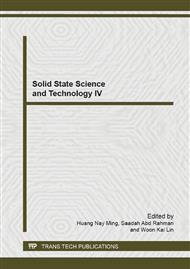p.490
p.500
p.505
p.509
p.513
p.520
p.526
p.531
p.535
Study the Electrical Properties and the Efficiency of Polythiophene with Dye and Chlorophyll as Bulk Hetero-Junction Organic Solar Cell
Abstract:
The main focus in this work is to study the electrical properties and efficiency of the mixtureof organic materials that can absorb wide range of light spectrum. Polythiophene (PT) as the main active ingredient acts as a acceptor that absorb light in range 200 -350 nm, while the tris (8-hidroxyquinoline aluminum)(Alq3)and chlorophyll acts as a donor that can absorb light from 350 nm to 700 nm. The combination of PT:Alq3:Chlo is called as bulk heterojunction in organic solar cell.The thin film of the mixture was deposited by using spin coating technique. The energy gap and electrical conductivity of thin films were measured by UV-VIS and 4-point probe respectively. The efficiency of thin film solar cell was determined by 2-point probe. Result of energy band gap of PT:Alq3:Chlo thin film is about 3.72+ 0.02 eV. The electrical conductivity showed increase with the increasing of light intensity. The conductivity of PT:Alq3:Chlo thin film at ratio 3:1:2 under radiation of 100Wm-2 is about 0.250+ 0.001 Scm-1 andthe power conversion efficiency is ~7.16%.
Info:
Periodical:
Pages:
513-519
Citation:
Online since:
February 2014
Keywords:
Price:
Сopyright:
© 2014 Trans Tech Publications Ltd. All Rights Reserved
Share:
Citation:



